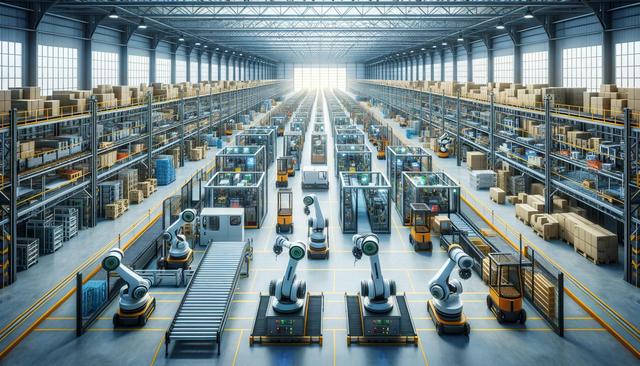The Evolution of Warehouse Management
Warehouse operations have undergone a significant transformation in recent years, largely driven by the increasing demand for faster delivery times, higher accuracy, and greater efficiency in logistics. Traditional manual processes, which once dominated warehouses, are steadily being replaced by automated technologies. These changes are not only improving operational productivity but also reshaping the way businesses approach inventory control and order fulfillment. Automating routine tasks such as picking, packing, and sorting helps eliminate human error and reduces the need for extensive labor, especially during peak seasons.
Initially, warehouse automation involved basic mechanization, such as conveyor belts and barcode scanners. Today, it encompasses a wide range of intelligent systems, including autonomous mobile robots (AMRs), automated guided vehicles (AGVs), and advanced inventory tracking software. These innovations allow for seamless integration between various stages of the supply chain, ensuring that goods move efficiently from receiving to shipping. As a result, businesses can maintain better control over their inventory, minimize waste, and improve overall responsiveness to market demands.
Key Components of Warehouse Automation
Modern warehouse automation systems consist of several core components that work in harmony to streamline logistics operations. These components are designed to handle repetitive tasks with speed and precision, freeing up human workers to focus on more strategic activities. Some of the most commonly used technologies in automated warehouses include:
- Automated storage and retrieval systems (AS/RS): These systems use cranes, shuttles, or robots to move goods in and out of storage locations, optimizing space utilization and retrieval speed.
- Conveyor and sortation systems: Conveyors transport goods throughout the facility, while sorters direct items to the appropriate locations based on destination or order type.
- Warehouse execution software (WES): WES coordinates the activities of machines and workers, ensuring efficient task allocation and real-time visibility.
- Robotic picking and packing: Robotic arms equipped with vision systems can accurately pick and pack items, adapting to different shapes and sizes.
Each of these components contributes to the overall efficiency and reliability of warehouse operations. When integrated effectively, they can significantly reduce processing times and improve order accuracy.
Benefits for Logistics and Supply Chain Management
Warehouse automation offers a wide range of benefits for logistics and supply chain operations. By reducing reliance on manual labor and enhancing process consistency, automation leads to measurable improvements in key performance indicators. One of the most notable advantages is increased throughput, allowing warehouses to process more orders in less time. Additionally, automation helps reduce labor costs and mitigate the impact of workforce shortages, which are common in many regions.
Other benefits include:
- Improved inventory accuracy: Automated systems track inventory in real time, reducing discrepancies and stockouts.
- Faster order fulfillment: Streamlined processes enable quicker picking, packing, and shipping of goods.
- Enhanced workplace safety: Automation reduces the need for workers to perform physically demanding or repetitive tasks.
- Scalability: Automated systems can be easily scaled up or modified to accommodate changing business needs.
These benefits not only improve internal operations but also enhance customer satisfaction by ensuring timely and accurate deliveries.
Challenges and Considerations in Implementation
While the advantages of warehouse automation are clear, implementing these systems can come with challenges. One of the primary concerns for businesses is the initial investment cost, which can be substantial depending on the size and complexity of the operation. It is essential to conduct a thorough cost-benefit analysis and ensure that the anticipated return on investment justifies the expenditure.
Another consideration is the integration of new technologies with existing systems. Successful automation requires seamless communication between hardware and software components. Ensuring compatibility and minimizing disruption during implementation are critical for achieving desired outcomes. Additionally, companies must invest in training their workforce to operate and maintain automated systems effectively.
Other potential challenges include:
- Customization needs: Off-the-shelf solutions may not fit every operation, requiring tailored configurations.
- Downtime during transition: Installing and testing new systems can temporarily slow operations.
- Cybersecurity risks: Connected systems must be secured against potential cyber threats.
Addressing these challenges proactively can help businesses maximize the value of their automation investments.
The Future of Warehouse Automation
As technology continues to evolve, the future of warehouse automation looks increasingly promising. Emerging trends such as artificial intelligence (AI), machine learning, and the Internet of Things (IoT) are expected to further enhance the capabilities of automated systems. AI-powered analytics can optimize inventory levels and predict demand patterns, while IoT sensors provide real-time data on equipment performance and environmental conditions.
Another exciting development is the growing use of collaborative robots, or cobots, which work alongside human operators to boost productivity without replacing jobs entirely. These machines are designed to be safe, flexible, and easy to program, making them ideal for dynamic warehouse environments. In addition, advancements in battery technology and wireless communication are enabling more efficient mobile robots and reducing infrastructure requirements.
Looking ahead, warehouse automation will continue to play a vital role in meeting the demands of e-commerce, omnichannel fulfillment, and global supply chains. Companies that embrace these innovations will be better positioned to adapt to market changes and maintain a competitive edge.
Conclusion: Embracing Automation for Smarter Logistics
Warehouse automation is transforming logistics by introducing smarter, faster, and more reliable processes. Businesses across industries are recognizing the value of automated systems in improving efficiency, reducing errors, and enhancing customer satisfaction. By investing in the right technologies and addressing implementation challenges thoughtfully, companies can achieve significant operational improvements and long-term cost savings. As the logistics landscape continues to evolve, adopting warehouse automation is becoming not just an option, but a strategic necessity for growth and resilience.




Leave a Reply